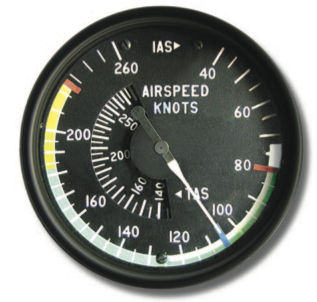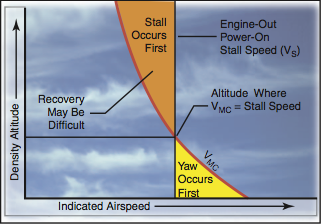Minimum Control Speed (Vmc)
To begin our Vmc discussion, a quote from Brett Godfrey's account of his left engine failure in a Cessna Golden Eagle twin at night over mountainous. You can read the full story here.
"I remembered being interviewed as a guest television commentator after two twin-engine airplanes crashed near my law office a few years ago. I explained to the viewers that twin-engine airplanes flying on only one engine suffer so much loss of performance that the pilot often tries to keep the bird in the air with too much back pressure on the stick. This works for a little while, but carries a deadly price: The pilot bleeds off airspeed until the plane loses rudder control, and the unbalanced torque of an off-center engine flips the plane into a death-spin."
What is he talking about? The answer is Vmc.
Vmc is one of the airspeeds we discussed on the airspeed page. It is defined as the minimum airspeed at which, during certification, the flight test pilot is able to (1) stop the turn that results when the critical engine is suddenly made inoperative within 20° of the original heading, using maximum rudder deflection and a maximum of 5° bank, and (2) thereafter, maintain straight flight with not more than a 5° bank.
As airspeed decays and falls below Vmc, the rudder loses authority, eventually leading to the airplane becoming uncontrollable in either yaw, roll, or both. Vmc is a critical concept to the safety of multi-engine flight, and you must strive to maintain airspeed at or above Vmc at all times.
Vmc is published in the POH and is denoted on the airspeed indicator by the red line.

Due to certification requirements and practices, the Vmc found in the POH is generally determined under "worst case" conditions, however, note that Vmc can be significantly above what is in the POH or indicated on ASI if proper bank is not established. Vmc is determined with the airplane banking no more than 5° into the working engine.
Additionally, note that Vmc is not a static number, it changes with a number of conditions. See below for some of the variables that determine Vmc and their effect:
- Vmc decreases as weight increases - weight adds to stability
- Vmc decreases as CG shifts forward - longer moment arm for rudder effectiveness
- Vmc decreases as power on operating engine is decreased - yaw and roll diminished
- Vmc decreases with altitude - engine producing less power, thus lower asymmetric thrust
- Vmc decreases with the landing gear lowered - gear stabilizes via keel effect
- Vmc decreases as drag decreases on the inoperative engine - highest when propeller windmilling
While Vmc decreases with altitude, stall speeds remain the same. Thus, Vmc and stall speed eventually converge at some altitude, above which airplane will stall before Vmc is reached. The altitude at which this occurs is not typically published in operating handbooks.

Vmc is reduced significantly with increases in bank angle. Conversely, Vmc increases significantly with decreases in bank angle. Tests have shown that Vmc may increase more than 3 knots for each degree of bank less than 5°. Loss of directional control may be experienced at speeds almost 20 knots above published Vmc when the wings are held level.
Vmc Demonstration
The PTS for the multi-engine class requires that a Vmc demo be performed in the takeoff configuration, with landing gear retracted, and the critical engine failed. The maneuver must be completed at or above 5,000 feet AGL. Here are the steps for the demonstration:
- Retract gear
- Flaps up
- Trim for takeoff
- Reduce power on left (critical engine) and leave propeller windmilling
- Increase to full power on right engine
- Pitch up slowly to reduce airspeed approximately 1 knot per second
- When no longer able to maintain directional control with rudder, reduce power to idle on both engines and reduce angle of attack
- Recover using power of right engine only
During a Vmc demo, if there are ANY symptoms of an impending stall, the maneuver should be terminated immediately. The angle of attack should reduced as the throttle is retarded and the airplane returned to the entry airspeed. A Vmc demo that is allowed to degrade into a single-engine stall with high asymmetrical thrust is very likely to result in a loss of control of the airplane.
This is as good a time as any to mention that light twins are not required to complete spin recovery during certification, so a stall during a high-power OEI operation is very likely to make you a test pilot.
ACS Test Standards Limitations
You see by now how critically important the concept of Vmc is to multi-engine flying. To that end, here are a couple of limitations published in the PTS regarding engine cuts during the practical exam:
- The failure of an engine shall not be simulated until attaining at least Vsse/Vyse and at an altitude not lower than 400 feet AGL
- When simulating engine failure on the runway, it shall be accomplished before reaching 50% of the calculated Vmc
An unfortunate series of accidents over the years in both training and certification have led to these limitations. Please make sure both you and your examiner understand them thoroughly before climbing into the airplane together.